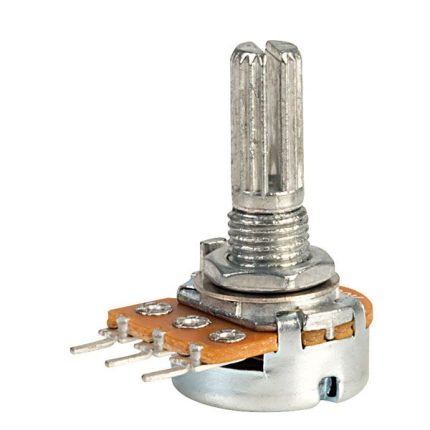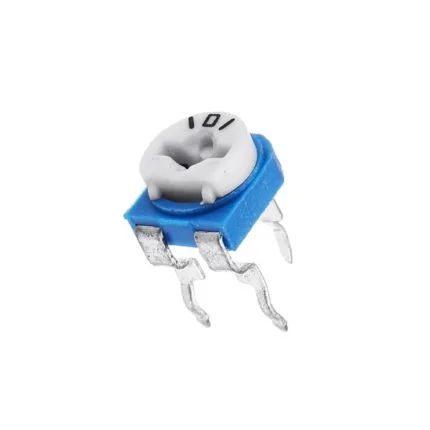Rotary Potentiometer 50k Ohm vary their resistive value as a result of an angular movement. Rotating a knob or dial attached to the shaft causes the internal wiper to sweep around a curved resistive element. The most common use of a rotary potentiometer is the volume-control pot.
Rotary Potentiometer 50k Ohm is designed to be mounted onto the front panel of a case, enclosure or printed circuit board (PCB) using a ring nut and locking washer. They can also have one single resistive track or multiple tracks, known as a ganged potentiometer that all rotate together using one single shaft. For example, a dual-gang pot to adjust the left and right volume control of a radio or stereo amplifier at the same time. Some rotary pots include on-off switches.
This Rotary Potentiometer 50k Ohm can produce a linear or logarithmic output with tolerances of typically 10 to 20 percent.
As they are mechanically controlled, they can be used to the measure the rotation of a shaft, but a single-turn rotary potentiometer normally offers less than 300 degrees of angular movement from minimum to maximum resistance.
However, multi-turn potentiometers, called trimmers, are available that allow for a higher degree of rotational accuracy.
Rotary Potentiometer 50k Ohm Multi-turn allow for a shaft rotation of more than 360 degrees of mechanical travel from one end of the resistive track to the other. Multi-turn pots are more expensive, but very stable with high precision used mainly for trimming and precision adjustments. The two most common multi-turn potentiometers are the 3-turn (1080o) and 10-turn (3600o), but 5-turn, 20-turn and higher 25-turn pots are available in a variety of ohmic values.
Features: –
There is no chance of getting errors because it uses the zero reflection method.
The standardization can be done by using a normal cell directly
It is used to measure small emf’s due to highly sensitive
Based on the requirement, the potentiometer length can be increased to get accuracy.
When the potentiometer is used in the circuit for measurement then it doesn’t draw any current.
It is used to measure the inner resistance of a cell as well as compares the e.m.f. of two cells but by using a voltmeter, it is not possible.
Rotary Potentiometer 50k Ohm Specifications: –
Taper: Linear, audio
Standard Resistance Range: 1K – 10K ohms
Standard Resistance Tolerance: ±20 % Residual
Resistance: 1 % max.
Environmental Characteristics
Operating Temperature …-10 °C to +50 °C
Power Rating Linear: 0.2 watt
Dual Section: 0.125 watt
Audio: 0.1 watt
Dual Section: 0.06 watt
Maximum Operating Voltage Linear : 200 V Audio: 150 V
Sliding Noise: 47 mV max1








Reviews
There are no reviews yet.